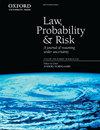法医科学中的不确定性和错误率:一种信号检测理论方法
IF 1.4
4区 社会学
Q1 LAW
引用次数: 11
摘要
有时候,对于一个似乎包含有用识别信息的被质疑样本是否来自某个特定的已知来源,法医科学家可能难以得出确切的结论。在这种情况下,法医科学家可能会称这对样本为“不确定的”。我们建议信号检测理论(SDT),它涉及到在噪声环境中检测弱信号,为理解非结论性在各种特征匹配法医科学中所起的作用提供了一个有用的框架。SDT表明,“不确定”通常是一个适当的反应,这取决于样本中信号的强度和审查员采用的阈值。我们还认为,在制表法证错误率时,不应将非结论性结论编码为正确或不正确。本文章由计算机程序翻译,如有差异,请以英文原文为准。
Inconclusives and error rates in forensic science: a signal detection theory approach
There are times when a forensic scientist may not be comfortable drawing a firm conclusion about whether a questioned sample that appears to contain useful identifying information did or did not come from a particular known source. In such cases, the forensic scientist may call the sample pair ‘inconclusive’. We suggest that signal detection theory (SDT), which is concerned with the detection of weak signals in noisy environments, provides a useful framework for understanding the role that inconclusives play in the various feature-matching forensic sciences. SDT shows that ‘inconclusive’ is often an appropriate response depending on both the strength of the signal in the samples and the thresholds adopted by the examiner. We also argue that inconclusives should not be coded as either correct or incorrect when tabulating forensic error rates.
求助全文
通过发布文献求助,成功后即可免费获取论文全文。
去求助
来源期刊

Law Probability & Risk
MATHEMATICSSTATISTICS & PROBABILITY&-STATISTICS & PROBABILITY
CiteScore
2.10
自引率
28.60%
发文量
8
期刊介绍:
Law, Probability & Risk is a fully refereed journal which publishes papers dealing with topics on the interface of law and probabilistic reasoning. These are interpreted broadly to include aspects relevant to the interpretation of scientific evidence, the assessment of uncertainty and the assessment of risk. The readership includes academic lawyers, mathematicians, statisticians and social scientists with interests in quantitative reasoning.
The primary objective of the journal is to cover issues in law, which have a scientific element, with an emphasis on statistical and probabilistic issues and the assessment of risk.
Examples of topics which may be covered include communications law, computers and the law, environmental law, law and medicine, regulatory law for science and technology, identification problems (such as DNA but including other materials), sampling issues (drugs, computer pornography, fraud), offender profiling, credit scoring, risk assessment, the role of statistics and probability in drafting legislation, the assessment of competing theories of evidence (possibly with a view to forming an optimal combination of them). In addition, a whole new area is emerging in the application of computers to medicine and other safety-critical areas. New legislation is required to define the responsibility of computer experts who develop software for tackling these safety-critical problems.
 求助内容:
求助内容: 应助结果提醒方式:
应助结果提醒方式:


